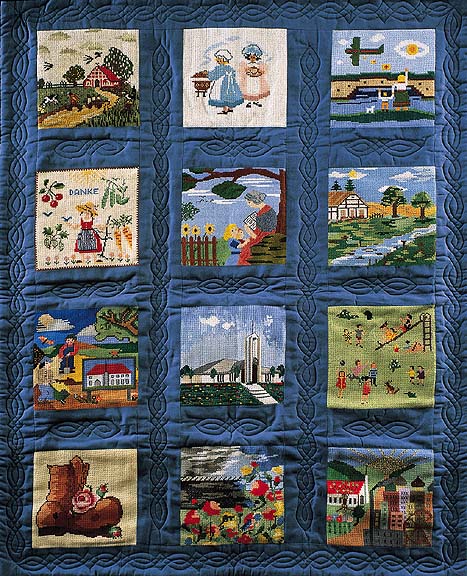“Be Ye Doers of the Word,” Ensign, Feb. 1999, 40
“Be Ye Doers of the Word”
Selected artwork from the Fourth International Art Competition sponsored by the Museum of Church History and Art.
The Apostle James urged the Saints to be “doers of the word, and not hearers only” (James 1:22). The Apostle John taught that we should show our love “in deed and in truth” (1 Jn. 3:18). Mormon wrote that “by their works ye shall know them; for if their works be good, then they are good also” (Moro. 7:5). As Latter-day Saints, we are a people of action, striving to do good in deed and in truth. We endeavor to follow gospel principles in our goal of coming unto Christ.
The third article of faith reinforces this teaching: “We believe that through the Atonement of Christ, all mankind may be saved, by obedience to the laws and ordinances of the Gospel.” [A of F 1:3]
Following is artwork that focuses on various gospel principles.

You Can’t Take It with You, by Rebecca C. Knudsen of Provo, Utah, praises service and compassion. “Everybody called her ‘Mom Burch.’ She opened her home to troubled teens and others who needed a place to stay and someone to talk to. She and her husband raised sheep and befriended Native Americans they met while in the mountains. One gave her a pair of beaded leather gloves as a token of friendship.”

Glorious Gladys, by Peter Bleakley of Kent, England, honors those who endure to the end. “Baptized at age nine in 1920, Gladys struggled alone for the first 30 years of her membership. She epitomizes the charity, devotion to duty, and grace of a true English lady.”

The Initial Act, by David Linn of Provo, Utah—which won an Award of Merit—symbolizes courage and faith. “Courage and the vision to see with an eye of faith are universal attributes. However, the pivotal moment comes when we step off the safe and well-worn path and move into unknown territory, guided only by the light of faith.”

The New Ocean, by Don Lind of Lake Oswego, Oregon, embodies hope in the future. He was an astronaut on the space shuttle Challenger in 1985. “As a rocket launches toward space, I see not only tremendous power and high adventure but also modern pioneers launching their fragile craft onto a new ocean. Their ship looks different, but the spirit is the same.”

“Sanctify to Thee Thy Deepest Distress,” by Judy Law of Springville, Utah—which won an Award of Merit—explores our earthly sufferings. “Mortality brings pain. But we live beyond earth life, and we are not alone and forgotten in our struggles and suffering here. Our loving Heavenly Father cares for us and sustains us. He will send strength, comfort, and peace. One day He will turn our faith to wisdom, our challenges to blessings, our suffering to joy.”

The First Christmas in Dixie, by Wallace G. Lee of St. George, Utah, pays tribute to resourcefulness. “It was a cold, rainy night in St. George in December 1861. Food, fuel, and shelter were scarce. A Christmas dance was held to cheer the Saints. The people each received a roasted potato to warm their hands and to eat later. Suddenly a fiddle string broke and there was no replacement. A sister had a spool of silk thread, and in candlelight the thread was twisted and stretched onto the fiddle. The substitute string worked and the dance continued.”

Calm in the Storm, by Linda Etherington of Fremont, California, reminds us of the peace that comes from the gospel of Jesus Christ. “This mother is not unaware of the storm; nevertheless, she is at peace.”

Our Blanket of Faith, by Ingrid Frost of Michelstadt, Germany, celebrates the faith of Latter-day Saints in East and West Germany, who worked together to rebuild their common country and to do the work of the Lord.

Put Your Shoulders to the Wheel, by Milton E. Jones Jr. of Orem, Utah, glorifies work. “How important it is to put our efforts into obeying God’s command and subduing the elements instead of one another.”